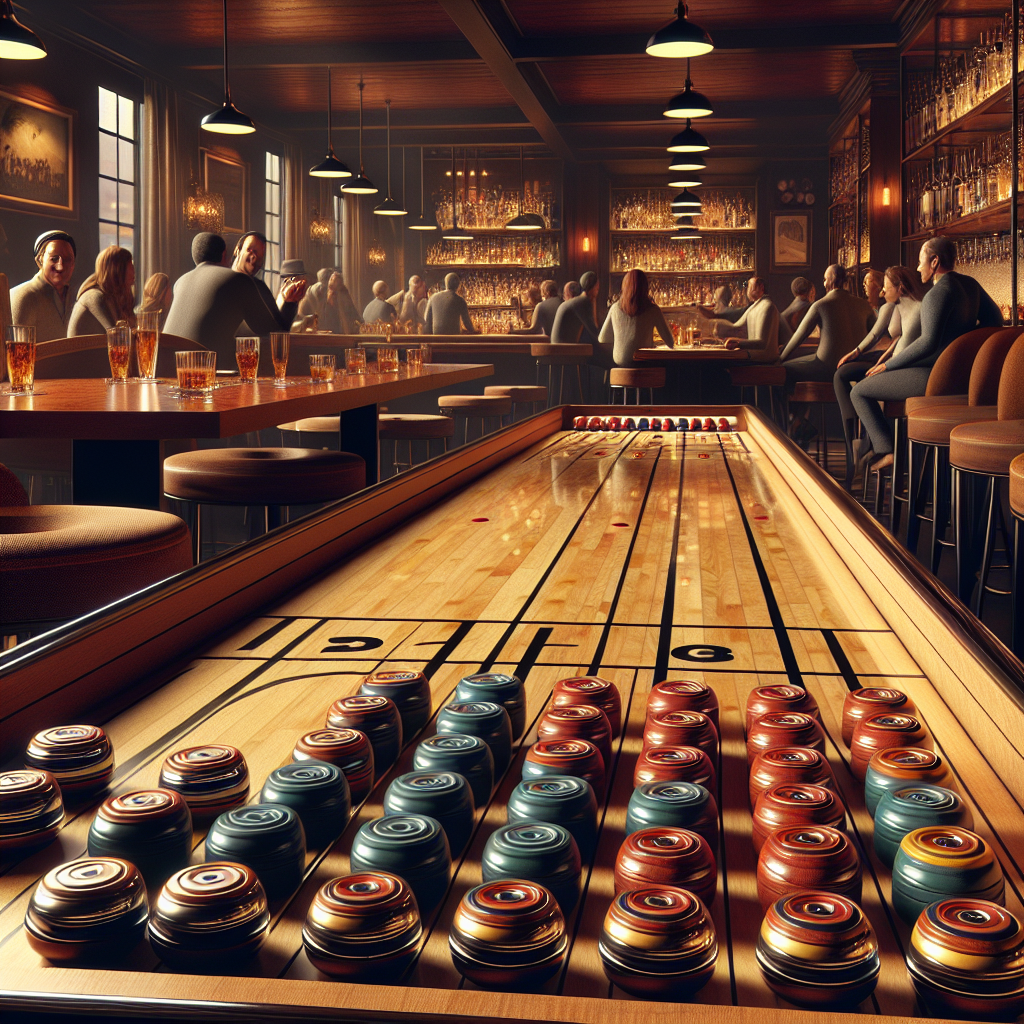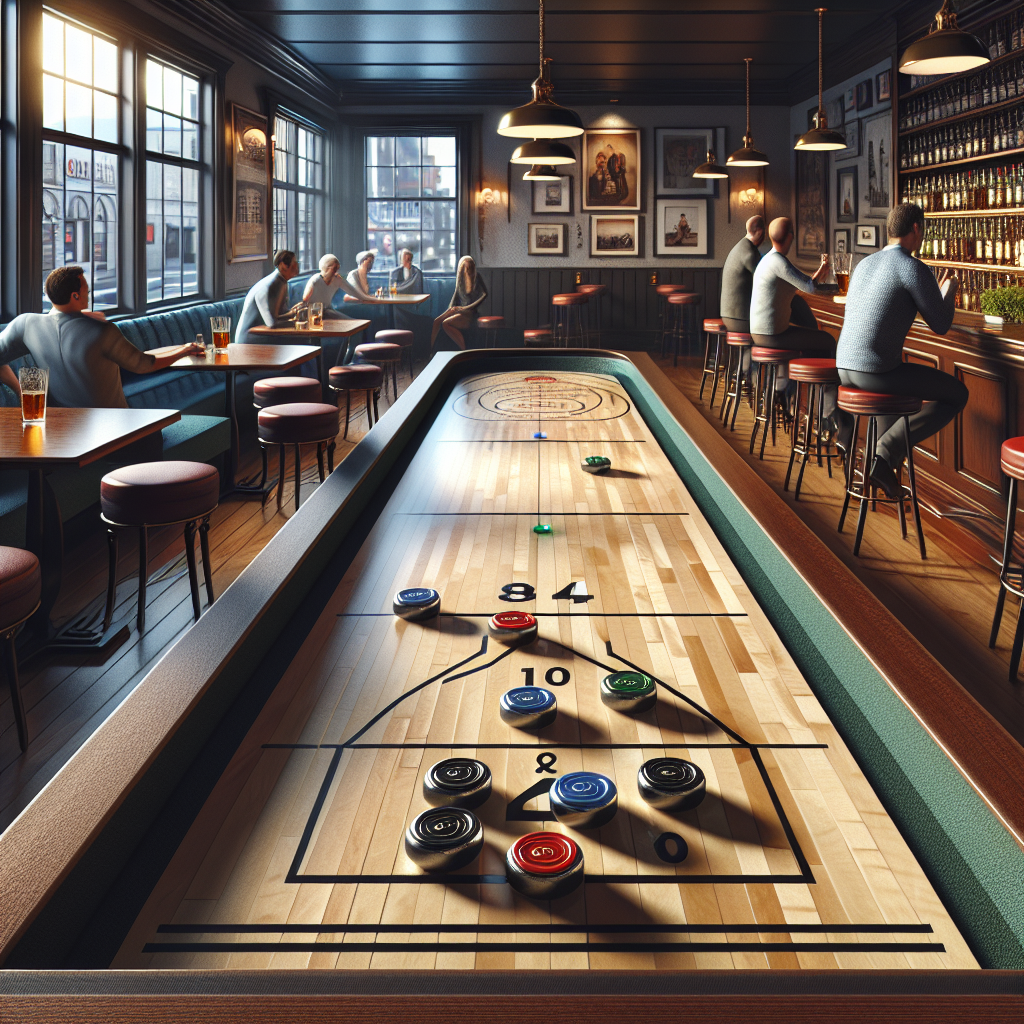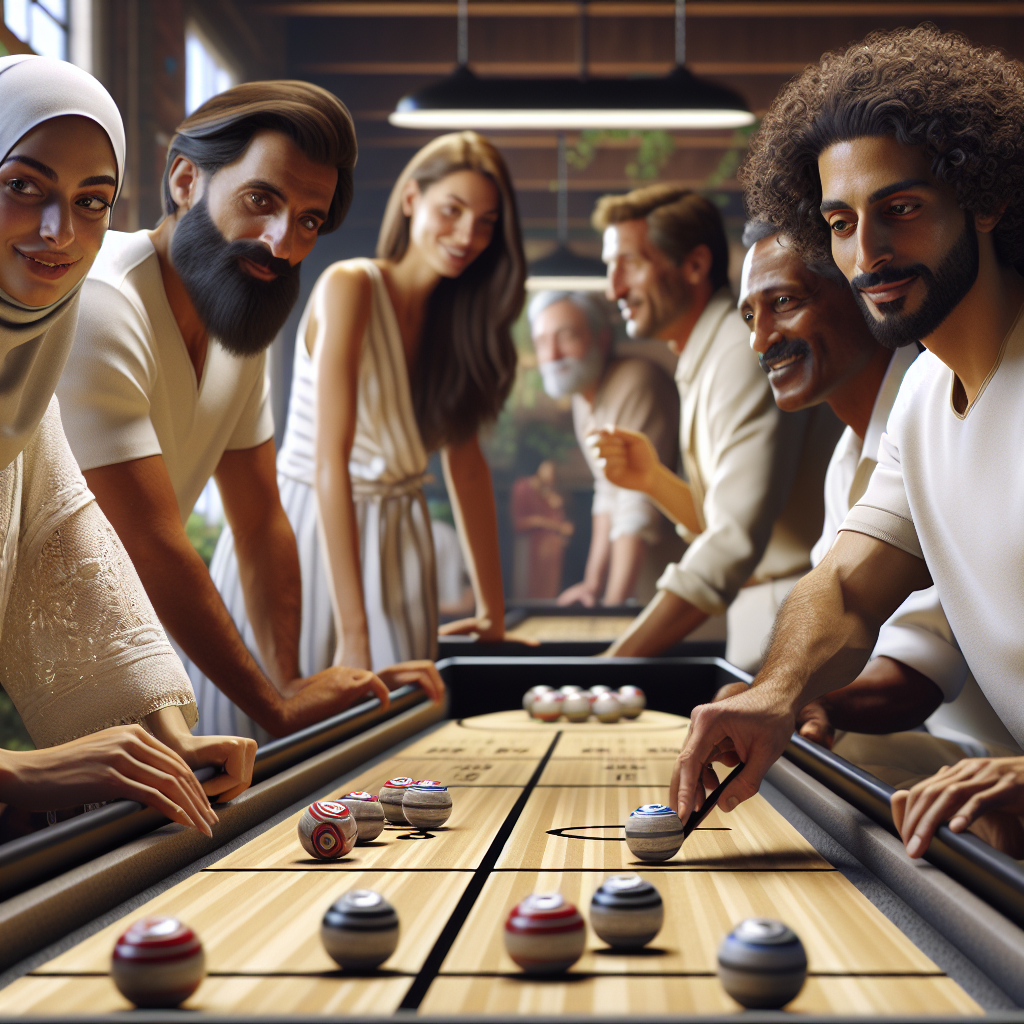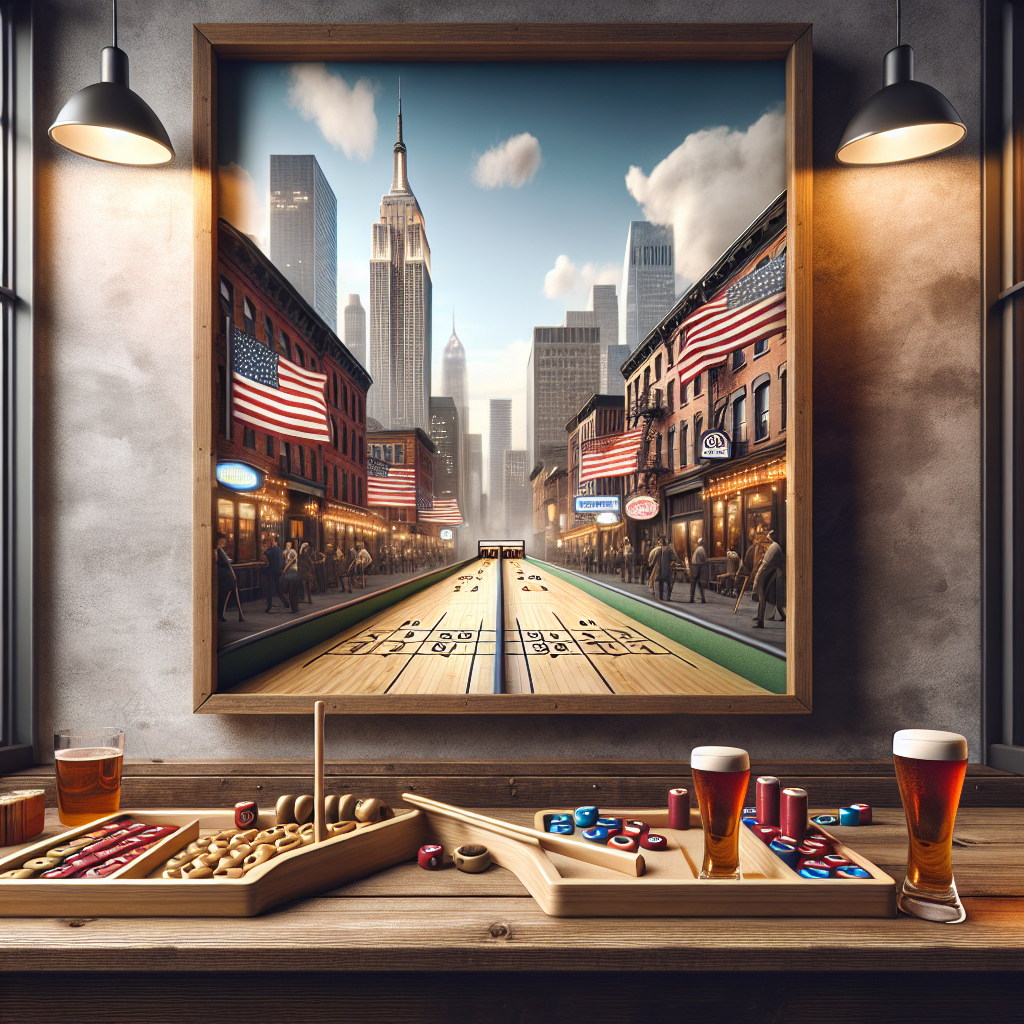Bar Shuffleboard Rules
When stepping up to a bar shuffleboard table, it’s important to familiarize yourself with the rules of the game. Understanding the objective and scoring zones will ensure an enjoyable and competitive experience.
Objective of the Game
The objective of bar shuffleboard is to slide weighted discs, commonly known as “pucks,” down a narrow and elongated table, aiming to have them come to rest within a marked scoring area. The goal is to accumulate points by strategically placing the pucks in the highest scoring zones.
Scoring Zones and Points
The bar shuffleboard table is divided into different scoring zones, each with its own point value. The scoring zones are typically marked on the table surface and are divided into three main sections: the 1-point zone, the 2-point zone, and the 3-point zone.
| Scoring Zone | Point Value |
|---|---|
| 1-Point Zone | 1 |
| 2-Point Zone | 2 |
| 3-Point Zone | 3 |
The pucks that come to rest within these scoring zones earn the corresponding points. The closer a puck is to the end of the table, the higher the potential for scoring.
In bar shuffleboard, the game is typically played in rounds, and the player or team with the highest total points at the end of the game is declared the winner. The specific number of rounds can vary depending on the establishment or players’ preferences.
It’s important to note that certain fouls or violations can result in penalties, such as the removal of pucks from the scoring zone. Familiarize yourself with the specific rules and regulations of the bar or establishment where you are playing.
Now that you understand the objective of the game and the scoring zones, you’re ready to step up to the bar shuffleboard table and enjoy a spirited and competitive game. For more information on other aspects of bar shuffleboard, such as equipment and gameplay strategies, continue reading our comprehensive guide on bar shuffleboard.
Setting Up for Bar Shuffleboard
Before diving into a game of bar shuffleboard, it’s important to set up the playing environment and gather the necessary equipment. This section will guide you through the process of creating the ideal indoor play environment and provide insights into the equipment and dimensions involved.
Indoor Play Environment
Shuffleboard can be enjoyed indoors, making it a versatile game that can be played regardless of weather conditions. To create a competitive and enjoyable playing environment, consider the following:
-
Space: Ensure that you have enough space around the shuffleboard table for players to comfortably throw the discs. This will allow for smooth gameplay without the risk of obstacles hindering the movement of players or their shots.
-
Game Room Decor: Enhance the ambiance of your game room by adding decorative elements that complement the shuffleboard experience. Consider incorporating elements such as themed wall art, lighting fixtures, and comfortable seating to create an inviting atmosphere for players and spectators.
-
Alternative Games: To maximize the enjoyment of your game room, consider adding alternative games like 3-in-1 tables, darts, or wooden board games. This provides options for players with varying interests and ensures that everyone can find something they enjoy.
For more detailed information on the rules and gameplay of bar shuffleboard, refer to our article on bar shuffleboard rules.
Equipment and Dimensions
To play bar shuffleboard, you will need the following equipment:
-
Shuffleboard Table: The shuffleboard table is the centerpiece of the game. Official shuffleboard courts have specific dimensions, with a regulation size of 22 feet long by 20 inches wide (Wikipedia). However, for bar shuffleboard, the table size may vary. Typical home shuffleboard tables are generally 9, 12, or 14 feet long (Watson’s). The dimensions of the table determine the length of the playing surface and the space required in your bar.
-
Discs: Shuffleboard discs, also known as pucks or weights, are used to play the game. Each player typically has a set of four discs, usually in different colors to differentiate between players.
-
Table Wax: A special wax or silicone-based powder is applied to the shuffleboard table surface to reduce friction and allow the discs to slide smoothly. This waxing process is essential for optimal gameplay.
When setting up your bar shuffleboard game, it’s important to ensure that the dimensions of the playing area are suitable for the chosen table size. This includes considering the length and width of the table, as well as leaving enough space for players to comfortably maneuver.
For further information on the dimensions of shuffleboard tables and tips on maintenance, refer to our articles on bar shuffleboard dimensions and bar shuffleboard maintenance, respectively.
By creating an inviting indoor play environment and ensuring you have the necessary equipment and dimensions, you’ll be ready to enjoy a thrilling game of bar shuffleboard.
Gameplay Strategies
To master the art of playing bar shuffleboard, understanding turn order, techniques, scoring rules, and fouls is essential.
Turn Order and Techniques
Determining turn order is crucial in bar shuffleboard. The common practice is to flip a coin or use any agreed-upon method to decide who goes first. Once the turn order is established, players take turns sliding their discs down the shuffleboard table.
Executing precise disc slides is key to success. Players often use a technique called “cueing” or “cue shots” to achieve accuracy and control. By placing their hand on the shuffleboard table and using it as a pivot point, players can guide their disc with precision. It’s important to practice and develop a consistent technique to improve your gameplay.
Scoring Rules and Fouls
Scoring in bar shuffleboard is determined by the position of the discs on the shuffleboard table. The scoring zones and points may vary depending on the specific rules followed. It’s important to refer to the bar shuffleboard scoring rules to understand how points are awarded based on the disc’s position.
To ensure fair play, it’s crucial to be aware of fouls and penalties. Fouls can occur if a player fails to meet specific requirements during their turn, such as not reaching the scoring zone or knocking off another player’s disc illegally. Understanding the fouls and penalties outlined in the bar shuffleboard rules is essential to maintain a fair and enjoyable game.
Developing effective gameplay strategies can greatly enhance your performance in bar shuffleboard. Consider the following tips:
- Focus on precision: Aim for accuracy when sliding your disc to maximize your scoring potential.
- Employ defensive moves: Strategically place your discs to block your opponent’s scoring opportunities.
- Maintain control: Avoid overly aggressive shots that may result in your disc falling off the shuffleboard table.
- Adapt to changing conditions: As the wax on the shuffleboard table wears off or changes, adjust your technique accordingly.
- Observe opponents: Pay attention to your opponents’ strategies and scoring patterns to inform your own gameplay.
- Cultivate patience: Precision and strategy often require patience, so take your time to make calculated shots.
- Embrace enjoyment: Remember to have fun and enjoy the game, as a positive mindset can enhance your performance.
By familiarizing yourself with turn order, techniques, scoring rules, and fouls, you can elevate your bar shuffleboard skills. Practice regularly, explore different strategies, and embrace the enjoyment of the game to improve your chances of success. For additional tips, check out our article on bar shuffleboard tips.
History of Shuffleboard
Shuffleboard, a game that involves players using cues to push weighted discs down a narrow court to have them come to rest within a marked scoring area, has a long and fascinating history. Let’s explore the origins and evolution of shuffleboard, as well as the establishment of the International Shuffleboard Association (ISA).
Origins and Evolution
The roots of shuffleboard can be traced back to Tudor England, where it was known as “shovillabourde” and “shovelboard” (Wikipedia). The game gained popularity and spread throughout Europe over the years.
In the early 20th century, shuffleboard made its way to the United States, particularly to the sunny shores of Daytona Beach, Florida. In 1913, Robert Ball added a shuffleboard court in front of his Lyndhurst Hotel, marking the game’s introduction to American soil. The game quickly caught on in Daytona Beach and led to the establishment of clubs and regulations, such as the renowned St. Petersburg Shuffleboard Club in 1924.
Over time, shuffleboard evolved from a casual pastime to a competitive sport. Previously seen as an “older person’s game” or an “expensive bar table,” shuffleboard has gained popularity among players of all ages. Many enthusiasts have even installed shuffleboard tables in their homes, contributing to the game’s growing appeal (Shuffleboard Corner).
International Shuffleboard Association
To further promote shuffleboard on a global scale, the International Shuffleboard Association (ISA) was founded in 1979 in St. Petersburg, Florida. The ISA’s primary objective is to organize and oversee shuffleboard competitions internationally. One of its significant events is the Team World Championships, which began in 1981. Over the years, the championships have expanded to include participating countries such as Australia, Brazil, Germany, and the Netherlands (Wikipedia).
The establishment of the ISA has brought shuffleboard enthusiasts from different nations together, fostering a sense of camaraderie and healthy competition within the shuffleboard community. Through the efforts of the association, shuffleboard continues to grow as a recognized and celebrated sport worldwide.
Understanding the history of shuffleboard provides valuable context and appreciation for the game’s evolution. Now that we have explored the origins and development of shuffleboard, let’s dive into the basics of playing bar shuffleboard, including the rules, strategies, and techniques that will help you elevate your game.
Table Shuffleboard Basics
Table shuffleboard is a popular game that can be enjoyed in bars and recreational spaces. In this section, we will explore the basics of table shuffleboard, including the game setup, objectives, and scoring.
Game Setup and Objectives
The objective of table shuffleboard is to slide all four of one’s weights alternately against an opponent’s, aiming to reach the highest scoring area without falling off the board into the alley. The weights must be farther down the board than the opponent’s to be in scoring position, which can be achieved by either knocking off the opponent’s weights or outdistancing them (Shuffleboard Corner).
To set up the game, follow these steps:
- Place the shuffleboard table in a suitable playing area, ensuring that there is enough space around the table for players to comfortably move and shuffle the weights.
- Divide players into two teams, with one player from each team stationed at each end of the board.
- Determine the playing order, which can be decided by a coin toss or any fair method.
- Place the weights at the starting end of the table, with each player’s weights on their respective side.
Scoring and Game Completion
Table shuffleboard games continue for as many rounds as necessary until one player or team reaches a predetermined score, typically 15 or 21 points. When playing with four players, they compete as doubles teams of two players each, with one player from each team stationed at each end of the board.
After all weights in a round have been shuffled, the player whose leading weight is farthest away from the playing end wins the round. The winner’s score is determined by adding the values of all their leading weights that lie ahead of the loser’s leading weight. Only the winner scores in a round (Shuffleboard Corner).
Common courtesy, good sportsmanship, and good conduct are expected during a shuffleboard match. Players are required to follow guidelines such as not extending their lower body beyond the end of the shuffleboard table while shooting and not touching the playing surface of the board with their hands during or after making a shot (Shuffleboard Corner).
Understanding the rules and objectives of table shuffleboard is essential to enjoy the game and compete effectively. Now that you have a grasp of the basics, you can confidently engage in exciting matches with friends and fellow players. If you’re looking for more tips and strategies to improve your shuffleboard skills, check out our article on bar shuffleboard strategy.
Improving Shuffleboard Skills
To become a skilled player in bar shuffleboard, it’s important to focus on practice and strategy development. By honing your skills and understanding the nuances of the game, you can enhance your gameplay and increase your chances of success.
Practice Tips
Improving your shuffleboard skills requires consistent practice and dedication. Here are some tips to help you enhance your game:
-
Master the Basics: Start by familiarizing yourself with the bar shuffleboard rules and understanding the scoring zones and points. This knowledge forms the foundation for your practice sessions.
-
Focus on Technique: Pay attention to your stance, grip, and delivery technique. Experiment with different techniques and find the one that works best for you. Practice your sliding motion and aim for accuracy and control.
-
Experiment with Speed and Force: Vary the speed and force with which you slide the puck to achieve different results. Practice finesse shots that require gentle movements as well as more forceful shots to knock opponents’ pucks out of scoring positions.
-
Target Specific Areas: Concentrate on targeting specific scoring zones to improve your precision. Practice aiming for different sections of the scoring triangle to develop consistency.
-
Challenge Yourself: Set up specific practice drills to target different aspects of the game. For example, you can practice clearing opponents’ pucks, placement shots, or defensive strategies.
-
Observe and Learn: Watch experienced players in action and learn from their techniques and strategies. Pay attention to their body positioning, shot selection, and decision-making process. Incorporate these observations into your own practice sessions.
Strategy Development
Developing a solid strategy is key to success in bar shuffleboard. Here are some strategies to consider:
-
Assess the Board: Before making your shot, evaluate the current state of the board. Take note of the positions of your pucks, as well as your opponents’ pucks. Identify scoring opportunities and areas that require defensive measures.
-
Block and Defend: Use strategic placement of your pucks to block your opponents’ scoring zones. By placing pucks strategically, you can make it challenging for your opponents to score and force them to make riskier shots.
-
Utilize the Hammer: The last shot in a round, known as the “hammer,” is a crucial opportunity to score additional points. Save your strongest shot for the hammer and aim for high-scoring areas.
-
Adapt to Changing Conditions: Be flexible and adjust your strategy based on the progress of the game. Take into account the positions of the pucks after each turn and adapt your shots accordingly.
-
Mind the Risk-Reward Balance: Consider the risks and rewards associated with different shots. Sometimes it may be more beneficial to play defensively and prevent your opponents from scoring, while other times a more aggressive approach may be necessary to secure a higher score.
By incorporating these practice tips and developing a strategic mindset, you can continue to improve your skills and enjoy the art and science of playing bar shuffleboard. Remember, practice makes perfect, so keep honing your skills and strive for mastery of the game.








